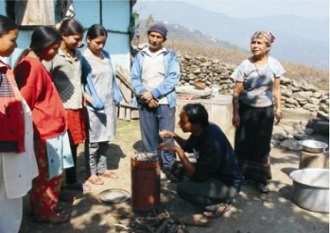Kenyan farmers could reap from carbon trading
Sept. 6, 2009
From the manicured lawns of San Diego, California, a little known company is breaking new ground in the business of personal carbon trading.
Carbon Manna Unlimited is pushing forward an ingenious pilot project that rewards small farmers in Mbeere and Bungoma districts for planting trees, and using more energy efficient stoves, known locally as jikos, for cooking.
To start of with, it is giving each family involved Sh2,200 per month sent through their mobile phones, using Zain Kenya’s Zap, and Safaricom’s M-Pesa. A personal carbon emission trading offers a financial carrot to individuals or families to get them to clean up their act.
The farmers involved in the Carbon Manna project will be allowed to emit only a certain amount of carbon dioxide (CO2), measured according to pre-agreed scale.
If they cut their emissions to below this limit, the balance is calculated in monetary terms, and they are paid for it.
Thanks to the financial incentive to operate below the limit, and the use of fuel efficient jikos, farmers plant more trees than they can cut down, thereby aiding the fight against deforestation, and reducing the CO2 emissions blamed for global warming.
The UN (United Nations) and other global institutions, have praised carbon trading as a way of reducing deforestation in developing countries like Kenya. The carbon credits payments project is now in its trial stage. Carbon Manna will subsidise the purchase the jikos in Kenya.
This project falls within what the UN defines as Clean Development Mechanism (CDM) executed in developing countries that cannot afford the technology changes required to lower carbon emissions.
“We are confident that this will work better for a majority of the people, because the new, improved jikos save firewood, and produce less carbon dioxide than traditional three stones cooking over open fires.
They generate carbon credits that can be sold to companies or individuals, who want to offset their own emissions,” says Mr Geoffrey Kiringa, the Country Leader and President of Carbon Manna Unlimited. The business may look complicated, but could spawn huge profits for the farmers and their intermediaries.
five million jikos
If all goes according to plan, Carbon Manna Unlimited estimates that families in Kenya and the developing world can earn up to $62.50 (Sh4850) of carbon credits per year for each family, thereby reducing CO2 emissions by about 2.5 tonnes annually per family.
They also save $50-100 (Sh3500-Sh7000) a year on biomass, or carbon-based fuels. “If you can distribute five million Jikos, you are talking about a lot of tonnage of carbon,” says Kiringa. This could add up to a business with modest costs and between $200 million (Sh15.4 billion) annual revenues.
But how does the carbon markets work? Typically, buyers of carbon credits are companies in the United States or the European Union, who want to reduce their greenhouse gas emissions, either voluntarily (in the United States), or because their emissions are regulated (in the European Union).
“Let’s assume that five billion people in the developing world and 1 billion families, if only 10 per cent of families converted to efficient charcoal cooking, and did not emit 2.5 tonnes per year per family of CO2,” says David Pallela, Founder of Carbon Manna Unlimited “If we go further and assume that there will be reduced deforestation from not cutting down trees (biomass), this modest conversion rate alone would offset the annual CO2 emissions of the entire United Kingdom,” Pallela notes.
buying credit
“Instead of directly cutting their own emissions, these companies choose to buy credits, usually from a bank, a company or a non-profit institution — frequently in the developing world — that has come up with a less expensive way to curb greenhouse gases,” he added.
The project represents a new twist; use of mobile phone money transfer.
“The mobile phone-based carbon micro credit system employs SMS (short message service) and unique identifiers, to allow millions of families to claim, on a bi-weekly or monthly basis, the carbon offsets they produce, by using more efficient cooking methods such as a modern charcoal stove or solar cooker, instead of an inefficient open-pit fire burning biomass,” explains Pallela.
“As a result, each family is able to monetise directly its own contribution to mitigating global warming, while also reducing nationwide rates of deforestation and desertification.”
Available information indicates pre-selling tens of thousands of tonnes of bundled carbon micro credits provides the start-up capital needed to buy stoves and cell phones for the participating families, thus making the system self-funding and markets-based.
Source – http://www.eastandard.net/mag/InsidePage.php?id=1144016370&cid=457



